The Netherlands entered World War II on May 10, 1940, when invading German forces quickly overran them. On December 7, 1941, after the attack on Pearl Harbor, the Netherlands government in exile also declared war on Japan. Operation Market Garden, which started in 1944, liberated the southern and eastern parts of the country, but full liberation did not come until the surrender of Germany on May 5, 1945.
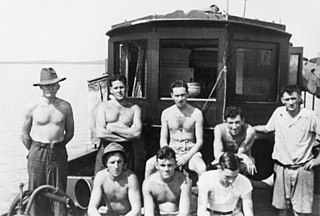
Z Special Unit was a joint Allied special forces unit formed during the Second World War to operate behind Japanese lines in South East Asia. Predominantly Australian, Z Special Unit was a specialist reconnaissance and sabotage unit that included British, Dutch, New Zealand, Timorese and Indonesian members, predominantly operating on Borneo and the islands of the former Netherlands East Indies.

The Indonesian Navy is the naval branch of the Indonesian National Armed Forces. It was founded on 10 September 1945 and has a role to patrol Indonesia's lengthy coastline, to enforce and patrol the territorial waters and Exclusive Economic Zone (EEZ) of Indonesia, to protect Indonesia's maritime strategic interests, to protect the islands surrounding Indonesia, and to defend against seaborne threats.
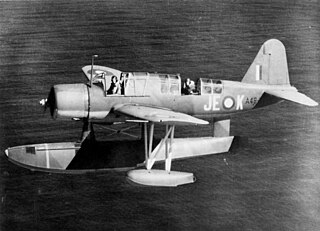
No. 107 Squadron was a Royal Australian Air Force maritime patrol squadron of World War II. It was formed in May 1943 and was equipped with Vought OS2U Kingfisher aircraft. The squadron conducted anti-submarine patrols off the Australian east coast during the last years of the war, but did not encounter any enemy submarines. It was disbanded in October 1945.
No. 119 Squadron was a joint Dutch and Australian squadron of World War II which formed part of the Royal Australian Air Force (RAAF). The squadron was formed in September 1943 but could not be made operational due to a shortage of Dutch personnel. As a result, it was disbanded in December 1943.
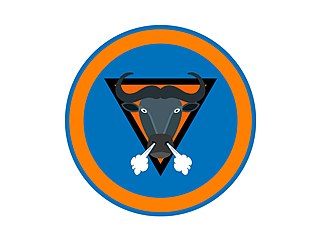
No. 120 Squadron was a joint Dutch and Australian squadron of World War II. The squadron was first formed in December 1943 as part of the Royal Australian Air Force (RAAF), and saw combat in and around New Guinea during 1944 and 1945 equipped with P-40 Kittyhawk fighters. Following the war, No. 120 Squadron was transferred to the Netherlands East Indies Air Force in 1946 and participated in the Indonesian National Revolution.

No. 18 Squadron was a joint Dutch and Australian bomber squadron of World War II. Formed in April 1942, the squadron was staffed by a mixture of Dutch and Australian personnel and placed under Royal Australian Air Force operational command. Initially it undertook anti-submarine patrols on the east coast of Australia, before moving to northern Australia and taking part in operations against the Japanese in the islands of the Netherlands East Indies (NEI). At the conclusion of hostilities, the squadron came under Dutch control and Australian personnel were transferred out. The squadron then undertook operations during the Indonesian National Revolution, before eventually being disbanded in July 1950 after being transferred to Indonesia.
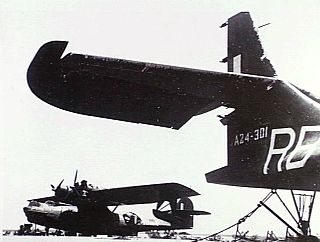
No. 42 Squadron was a Royal Australian Air Force (RAAF) mine laying and maritime patrol squadron of World War II. It was formed in June 1944 and conducted patrol and mine-laying operations over the Netherlands East Indies (NEI) from August 1944 until the war ended a year later, as well as operations in the waters off southern China in early 1945. Following the Japanese surrender, the squadron performed transport and reconnaissance flights until it was disbanded in November 1945.

No. 13 Squadron is a Royal Australian Air Force (RAAF) squadron. The squadron saw combat during World War II as a bomber and maritime patrol squadron and is currently active as a mixed regular and reserve RAAF unit located in Darwin, fulfilling both operational support and training duties.

The Royal Netherlands East Indies Army Air Force was the air arm of the Royal Netherlands East Indies Army in the Dutch East Indies from 1939 until 1950. It was an entirely separate organisation from the Royal Netherlands Air Force.

The Battle of Morotai, part of the Pacific War, began on 15 September 1944, and continued until the end of the war in August 1945. The fighting started when United States and Australian forces landed on the southwest corner of Morotai, a small island in the Netherlands East Indies (NEI), which the Allies needed as a base to support the liberation of the Philippines later that year. The invading forces greatly outnumbered the island's Japanese defenders and secured their objectives in two weeks. Japanese reinforcements landed on the island between September and November, but lacked the supplies needed to effectively attack the Allied defensive perimeter. Intermittent fighting continued until the end of the war, with the Japanese troops suffering heavy loss of life from disease and starvation.
Netherlands East Indies Forces Intelligence Service (NEFIS) was a Dutch World War II-era intelligence and special operations unit operating mainly in the Japanese-occupied Netherlands East Indies.

Fairbairn, formerly RAAF Base Fairbairn, is a former Royal Australian Air Force (RAAF) military air base, located in Australia's national capital, Canberra, Australian Capital Territory. Over the years the name of the establishment, and the use of the land, has changed. The base was in use by the RAAF between 1940 and 2007, when the land occupied north and east of the Canberra Airport runways was sold to Capital Airport Pty Limited for the purposes of advancing civil aviation and the development of a business park.
120 Squadron was a Netherlands East Indies Air Force unit which was later re-raised part of the Royal Netherlands Air Force. The squadron was first formed in December 1943 as part of the Royal Australian Air Force (RAAF), and saw combat in and around New Guinea during 1944 and 1945 equipped with P-40 Kittyhawk fighters. No. 120 Squadron was transferred to the Netherlands East Indies Air Force in 1946 and attacked Indonesian forces during the Indonesian National Revolution. It was disbanded in 1950 as a result of the Dutch–Indonesian Round Table Conference, but was re-formed in 1961 as an air defence unit. 120 Squadron was disbanded in 1983.
19e Transport Squadron, also known as No. 19 Squadron, was a transport and communications unit of the Militaire Luchtvaart van het Koninklijk Nederlands-Indisch Leger, formed in Australia during the final stages of World War II. The squadron was formed as a Dutch unit in late 1944 from two transport flights that had previously been based in Brisbane and Melbourne, and which had run supplies to joint Australian-NEI combat squadrons in the Northern Territory and in West Papua. Upon formation the squadron was based at Archerfield, near Brisbane. In 1945, it was transferred to the Royal Australian Air Force (RAAF), but returned to Dutch control in 1947 and subsequently took part in operations during the Indonesian National Revolution.
The Black Armada was a name applied to Dutch merchant and military vessels which were prevented from sailing to the newly proclaimed independent Indonesia from Australian ports due to waterfront strikes or 'black bans' by maritime trade unions from 1945 to 1949.
Operation Parsnip was the name given to an operation in World War Two by the Netherlands East Indies Forces Intelligence Service on the island of Java. Troops were landed by submarine on 6 June 1945. The party was spotted by the Japanese and picked up; two were killed.
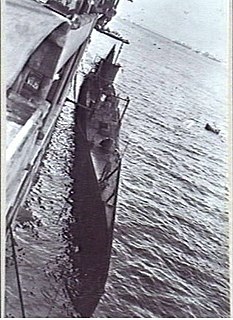
Operation Firtree was the name given to an operation in World War Two by theNetherlands East Indies Forces Intelligence Service in February 1945. The Dutch submarine HNLMS K XV unsuccessfully tried five times to land the NEFIS shore party 'Firetree' at the coast of the Soela Islands. The shore party was under the command of First Lieutenant J. Tahija.
Operation Inco I was the name given to an operation in World War Two by the Netherlands East Indies Forces Intelligence Service on the island of Java. On 7 July 1945 the Dutch submarine K XV lands personnel and supplies of the shore party 'Inco I' at six different places on the coast of the Damar islands.












